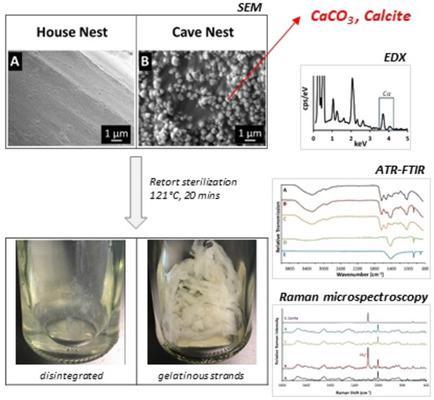当前位置:
X-MOL 学术
›
Chem. Asian J.
›
论文详情
Our official English website, www.x-mol.net, welcomes your
feedback! (Note: you will need to create a separate account there.)
Calcite Deposits Differentiate Cave from House-Farmed Edible Bird's Nest as shown by SEM-EDX, ATR-FTIR and Raman Microspectroscopy.
Chemistry - An Asian Journal ( IF 3.5 ) Pub Date : 2020-06-20 , DOI: 10.1002/asia.202000520 Eric Kian-Shiun Shim 1 , Soo-Ying Lee 1
Chemistry - An Asian Journal ( IF 3.5 ) Pub Date : 2020-06-20 , DOI: 10.1002/asia.202000520 Eric Kian-Shiun Shim 1 , Soo-Ying Lee 1
Affiliation

|
The difference between the swiftlet white edible bird's nest from limestone caves versus house‐farmed ones, especially in response to high temperature and stewing time in water where the latter type would disintegrate readily, has been a puzzle for a long time. We show that edible bird's nests from the limestone caves have calcite deposits on the surface of the nest cement as compared to the house‐farmed nests which are built by swiftlets on timber planks. The micron and sub‐micron calcite particles are seen in SEM‐EDX and further characterized by ATR‐FTIR and Raman microspectroscopy. The calcite deposits make it possible for the cave nest to retain a gelatinous texture under the harsh retort conditions at 121 °C for 20 mins in commercial bottling. We show that house‐farmed nests can be soaked in CaCl2(aq) followed by rinsing with Na2CO3(aq) to grow the same calcite deposits on the nest cement with the same characteristic as cave nests. Therefore, there should no longer be a need to harvest cave nests, and we can better conserve the dwindling population and natural habitats of cave swiftlets.
中文翻译:

SEM-EDX,ATR-FTIR和拉曼光谱学表明,方解石沉积物与家养食用燕窝的洞穴不同。
石灰岩洞穴中的白色燕窝与家禽巢之间的差异,尤其是对高温和炖煮时间的反应(后者会很容易分解)之间的差异,长期以来一直是一个难题。我们发现,与用金丝燕在木板上建造的房屋养殖巢相比,来自石灰岩洞穴的可食燕窝在巢水泥表面具有方解石沉积物。微米和亚微米方解石颗粒可见于SEM-EDX中,并通过ATR-FTIR和拉曼显微光谱进一步表征。在商业装瓶中,方解石沉积物使洞穴巢穴在121°C的苛刻蒸馏条件下保持20分钟的凝胶状质地成为可能。我们证明了可以将房屋养殖的巢浸泡在CaCl 2中(aq),然后用Na 2 CO 3(aq)冲洗,以在巢状水泥上生长与方孔相同的方解石沉积物。因此,不再需要收获洞穴巢穴,我们可以更好地保护日益减少的洞穴燕窝种群和自然栖息地。
更新日期:2020-08-18
中文翻译:

SEM-EDX,ATR-FTIR和拉曼光谱学表明,方解石沉积物与家养食用燕窝的洞穴不同。
石灰岩洞穴中的白色燕窝与家禽巢之间的差异,尤其是对高温和炖煮时间的反应(后者会很容易分解)之间的差异,长期以来一直是一个难题。我们发现,与用金丝燕在木板上建造的房屋养殖巢相比,来自石灰岩洞穴的可食燕窝在巢水泥表面具有方解石沉积物。微米和亚微米方解石颗粒可见于SEM-EDX中,并通过ATR-FTIR和拉曼显微光谱进一步表征。在商业装瓶中,方解石沉积物使洞穴巢穴在121°C的苛刻蒸馏条件下保持20分钟的凝胶状质地成为可能。我们证明了可以将房屋养殖的巢浸泡在CaCl 2中(aq),然后用Na 2 CO 3(aq)冲洗,以在巢状水泥上生长与方孔相同的方解石沉积物。因此,不再需要收获洞穴巢穴,我们可以更好地保护日益减少的洞穴燕窝种群和自然栖息地。











































 京公网安备 11010802027423号
京公网安备 11010802027423号